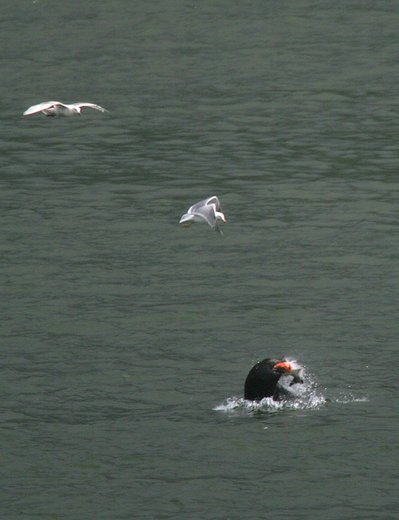forum
library
tutorial
contact

Strong Smelt Return Attracts Larger Sea Lion Numbers
to Columbia River as Springer Run Builds
by Staff
Columbia Basin Bulletin, April 4, 2014
|
the film forum library tutorial contact |

|
Strong Smelt Return Attracts Larger Sea Lion Numbers
by Staff
|
 Lookout. . . here they come.
Lookout. . . here they come.
Biologists counted about 1,420 California sea lions Monday nestled at docks at the East Mooring Basin in Astoria, which is double the 739 peak counted last year -- which was a record high number over the course of long-running monitoring of pinniped presence.
The previous high total was 370, according to Pacific State Marine Fisheries Commission wildlife biologist Matt Tennis.
"The sound is just incredible," Tennis said of the sea lions' crying and moaning as they rest between ventures out to plunder what is apparently a strong and continuing return of Pacific smelt, eulachon, to the Columbia River.
"I can't even hear people talk," Tennis said of the sea lion din at Astoria, a dozen or so miles inland from the Columbia's mouth at the Pacific Ocean.
With an apparent wealth of smelt pouring into the river, the big marine mammals eat, and rest and/or sleep at Astoria.
"They are here because of the smelt," Tennis said of the small, fat-filled fish that are a preferred option for almost exclusively male sea lions that forage up the coast between breeding seasons to fortify themselves.
More of the big beasts made their presence felt farther upriver since in the early 2000s, when increased returns of Columbia and Snake river spring chinook salmon caught their eye. Growing numbers of California sea lions found their way upstream to Bonneville Dam near river mile 146, and habitually gorged themselves on salmon spawners stalled briefly there in search of passage routes.
Concern for the welfare of wild salmon stocks, many listed under the federal Endangered Species Act, prompted the states of Oregon and Washington to seek permission from the federal government to remove sea lions found feeding on salmon below the dam. The sea lions are, for the most part, shielded by the Marine Mammal Protection Act from human harm.
Those sea lion removal permissions remain in place this year.
"We're certainly hoping that they don't go upriver and chase the springers," Tennis said of the marine mammals based for the time being down near the river mouth..
The U.S. Army Corps of Engineers' Robert Stansell noted that less than 10 percent of the California sea lions observed at Astoria this year are branded, while the past couple years it has been around 30-50 percent. Research led by the Oregon Department of Fish and Wildlife involves branding the animals so they can be later identified. Stansell heads research at the dam, which is operated by the Corps, aimed at assessing predatory marine mammal impacts on fish.
That ratio indicates that there are a lot of new recruits to the Astoria basin, likely brought in by the strong smelt run up the Columbia River this year, Stansell said.
Smelt returns had during the early part of the new century fallen to low points that prompted the species to be listed as threatened under the ESA. The last couple of years, however, have witnessed at bit of a rebirth, with what have been judged to be relatively strong returns to such former strongholds as southeast Washington's Cowlitz River and other lower Columbia tributaries.
The spring chinook return is in its early stages. A total of 308,000 adult fish is expected to return to the mouth of the Columbia, with an estimated 227,000 of that total destined for hatcheries and spawning grounds upstream of Bonneville Dam in the mid and upper Columbia and the Snake river basins.
Through Wednesday a total of 620 adult spring chinook had been counted passing over Bonneville's fish ladders so far this yeaer. That's more than double the 10-year average cumulative count through that date. Typically upriver spring chinook counts at Bonneville reach a peak in late April or early May.
"At least five California sea lions (Zalophus californianus -- CSL) have been seen at Bonneville so far this year," according to an April 3 report prepared by Stansell's research team. So far the California sea lions' appearances have been brief and sporadic.
Steller sea lion (Eumetopias jubatus - SSL) numbers have really picked up this past week, according to the report, but are still averaging much less than the past three years.
"The maximum number of SSL seen any day so far this year was 20. We have documented approximately 29 different SSL's visiting the dam so far. All but five of the SSL have been confirmed as seen in past years, although there are likely more new individuals. There have been many smaller Steller sea lions swimming in groups at the dam. It appears they are younger and have not been here before, however, we were unable to get good photo or video documentation of them."
"Total salmonid catch through April 2 (86 expanded by interpolating for weekends) is fewer than all previous years (2013 -- 217, 2012 -- 273, 2011 -- 506, 2010 -- 866, 2009 -- 636, 2008 -- 747, 2007 -- 502, 2006 - 543), all except one were by Steller sea lions," the report says. The Corps research began in 2002 to observe marine mammal presence and activity within the observable area below the dam. A goal has been to evaluate the extent of sea lion predation on, particularly, salmon and steelhead populations. Many of those stocks are protected under the Endangered Species Act.
learn more on topics covered in the film
see the video
read the script
learn the songs
discussion forum
